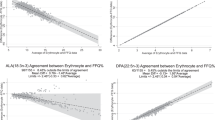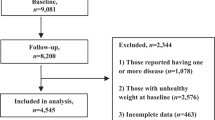Abstract
Background/Objectives:
B vitamins have been implicated in major chronic diseases but results have been inconsistent. This study evaluated the accuracy of dietary intakes of folate, vitamin B12, riboflavin and vitamin B6 as measured by the Northern Sweden Food Frequency Questionnaire (FFQ) against repeated 24-h recalls (24HR) and plasma levels, taking into consideration the MTHFR 677C>T polymorphism.
Subjects/Methods:
B vitamin intakes assessed by a semi-quantitative FFQ designed to measure the intake over the previous year were compared with those from 10 24HR, as well as to plasma levels of folate and vitamin B12, in randomly selected men (n=96) and women (n=99) aged 30–60 years. FFQ-based B-vitamin intakes were also compared with plasma levels of B-vitamins and with MTHFR 677C4T genotype in 878 men, aged 40–61 years.
Results:
Intakes of vitamins B12 and riboflavin were similar, whereas folate and B6 intakes were 16–27% higher, as estimated by FFQ versus 24HR. Spearman correlation coefficients between the two methods ranged from 0.31 to 0.63 (all P⩽0.002), and were lowest for vitamin B12. Intakes estimated by FFQ were correlated with plasma levels, but coefficients were lower (range: 0.13–0.33), particularly for vitamin B12 in men (0.15–0.18). Folate intake was not correlated with plasma levels in subjects with the MTHFR 677 T/T genotype.
Conclusions:
The validity of the Northern Sweden FFQ for assessing B vitamin intake is similar to that of many other FFQs used in large-scale studies. The FFQ is suitable for ranking individuals by intake of folate, riboflavin, vitamin B6 and to a lesser extent vitamin B12.
This is a preview of subscription content, access via your institution
Access options
Subscribe to this journal
Receive 12 print issues and online access
$259.00 per year
only $21.58 per issue
Buy this article
- Purchase on Springer Link
- Instant access to full article PDF
Prices may be subject to local taxes which are calculated during checkout

Similar content being viewed by others
References
Agudo A, Slimani N, Ocké MC, Naska A, EPIC Working Group on Dietary Patterns (2002). Vegetable and fruit consumption in the EPIC cohorts from 10 European countries. IARC Sci Publ 156, 99–103.
Bergström L (1979). Illustrations of food items (Swedish). Vår Föda 31 (Suppl 4), 401–403.
Bønaa KH, Njølstad I, Ueland PM, Schirmer H, Tverdal A, Steigen T, et al., NORVIT Trial Investigators (2006). Homocysteine lowering and cardiovascular events after acute myocardial infarction. N Engl J Med 354, 1578–1588.
Brantsaeter AL, Haugen M, Alexander J, Meltzer HM (2008). Validity of a new food frequency questionnaire for pregnant women in the Norwegian Mother and Child Cohort Study (MoBa). Matern Child Nutr 4, 28–43.
Brantsaeter AL, Haugen M, Hagve TA, Aksnes L, Rasmussen SE, Julshamn K et al. (2007). Self-reported dietary supplement use is confirmed by biological markers in the Norwegian Mother and Child Cohort Study (MoBa). Ann Nutr Metab 51, 146–154.
Cade JE, Burley VJ, Warm DL, Thompson RL, Margetts BM (2004). Food-frequency questionnaires: a review of their design, validation and utilisation. Nutr Res Rev 17, 5–22.
Casas JP, Bautista LE, Smeeth L, Sharma P, Hingorani AD (2005). Homocysteine and stroke: evidence on a causal link from Mendelian randomisation. Lancet 365, 224–232.
Drogan D, Klipstein-Grobusch K, Wans S, Luley C, Boeing H, Dierkes J (2004). Plasma folate as marker of folate status in epidemiological studies: the European Investigation into Cancer and Nutrition (EPIC)-Potsdam study. Br J Nutr 92, 489–496.
Erkkola M, Karppinen M, Javanainen J, Räsänen L, Knip M, Virtanen SM (2001). Validity and reproducibility of a food frequency questionnaire for pregnant Finnish women. Am J Epidemiol 154, 466–476.
Flood VM, Smith WT, Webb KL, Mitchell P (2004). Issues in assessing the validity of nutrient data obtained from a food-frequency questionnaire: folate and vitamin B12 examples. Public Health Nutr 7, 751–756.
French MR, Langdon C, Levy-Milne R (2001). Development of a validated food frequency questionnaire to determine folate intake. Can J Diet Pract Res 62, 82–86.
Frosst P, Blom HJ, Milos R, Goyette P, Sheppard CA, Matthews RG et al. (1995). A candidate genetic risk factor for vascular disease: a common mutation in methylenetetrahydrofolate reductase. Nat Genet 10, 111–113.
Guenther BD, Sheppard CA, Tran P, Rozen R, Matthews RG, Ludwig Martha L (1999). The structure and properties of methylenetetrahydrofolate reductase from Escherichia coli suggest how folate ameliorates human hyperhomocysteinemia. Nat Struct Biol 6, 359–365.
Håglin L, Hagman U, Nilsson M (1995). Evaluation of the meal model ‘matmallen’. A means of estimating consumed amounts of food. Scand J Nutr 39, 79–83.
Johansson G, Wikman Å, Åhrén A-M, Hallmans G, Johansson I (2001). Underreporting of energy intake in repeated 24-h recalls related to gender, age, weight status, day of interview, educational level, reported food intake, smoking habits and area of living. Public Health Nutr 4, 919–927.
Johansson I, Hallmans G, Wikman Å, Biessy C, Riboli E, Kaaks R (2002). Validation and calibration of food frequency questionnaire measurements in the Northern Sweden Health and Disease cohort. Public Health Nutr 5, 487–496.
Johansson M, Van Guelpen B, Vollset SE, Hultdin J, Bergh A, Key T et al. (2009). One-carbon metabolism and prostate cancer risk: prospective investigation of seven circulating B vitamins and metabolites. Cancer Epidemiol Biomarkers Prev 18, 1538–1543.
Kelleher BP, Broin SD (1991). Microbiological assay for vitamin B12 performed in 96-well microtitre plates. J Clin Pathol 44, 592–595.
Kim YI (2008). Folic acid supplementation and cancer risk: point. Cancer Epidemiol Biomarkers Prev 17, 2220–2225.
Kristal AR, Potter JD (2006). Not the time to abandon the food frequency questionnaire: counterpoint. Cancer Epidemiol Biomarkers Prev 15, 1759–1760.
Liem A, Reynierse-Buitenwerf GH, Zwinderman AH, Jukema JW, van Veldhuisen DJ (2005). Secondary prevention with folic acid: results of the Goes extension study. Heart 91, 1213–1214.
Lonn E, Yusuf S, Arnold MJ, Sheridan P, Pogue J, Micks M, et al., Heart Outcomes Prevention Evaluation (HOPE) 2 Investigators (2006). Homocysteine lowering with folic acid and B vitamins in vascular disease. N Engl J Med 354, 1567–1577.
Malouf R, Grimley Evans J (2008). Folic acid with or without vitamin B12 for the prevention and treatment of healthy elderly and demented people. Cochrane Database Syst Rev 4, CD004514.
Marks GC, Hughes MC, van der Pols JC (2005). The effect of personal characteristics on the validity of nutrient intake estimates using a food-frequency questionnaire. Public Health Nutr 9, 394–402.
Maruti SS, Ulrich CM, White E (2009). Folate and one-carbon metabolism nutrients from supplements and diet in relation to breast cancer risk. Am J Clin Nutr 89, 624–633.
Mathers JC (2009). Folate intake and bowel cancer risk. Genes Nutr 4, 173–178.
Messerer M, Johansson SE, Wolk A (2001). Use of dietary supplements and natural remedies increased dramatically during the 1990s. J Intern Med 250, 160–166.
Midttun O, Hustad S, Solheim E, Schneede J, Uveland PM (2005). Multianalyte quantification of vitamin B6 and B2 species in the nanomolar range in human plasma by liquid chromatography-tandem mass spectrometry. Clin Chem 51, 1206–1216.
Molloy AM, Scott JM (1997). Microbiological assay for serum, plasma, and red cell folate using cryopreserved, microtiter plate method. Methods Enzymol 281, 43–53.
O’Broin S, Kelleher B (1992). Microbiological assay on microtitre plates of folate in serum and red cells. J Clin Pathol 45, 344–347.
Ocké MC, Bueno-de-Mesquita HB, Pols MA, Smit HA, van Staveren WA, Kromhout D (1997). The Dutch EPIC food frequency questionnaire. II. Relative validity and reproducibility for nutrients. Int J Epidemiol 26 (Suppl 1), S49–S58.
Riboli E, Kaaks R (1997). The EPIC project: rationale and study design. European prospective investigation into cancer and nutrition. Int J Epidemiol 26 (Suppl 1), S6–S14.
Schofield W (1985). Predicting basal metabolic rate, new standards and review of previous work. Hum Nutr Clin Nutr 39 (Suppl 1), 5–41.
Stegmayr B, Lundberg V, Asplund K (2003). The events registration and survey procedures in the Northern Sweden MONICA Project. Scand J Public Health 31 (Suppl 61), 9–17.
Suitor CW, Bailey LB (2000). Dietary folate equivalents: interpretation and application. J Am Diet Assoc 100, 88–94.
Tanaka T, Scheet P, Giusti B, Bandinelli S, Grazia Piras M, Usala G et al. (2009). Genome-wide association study of vitamin B6, vitamin B12, folate, and homocysteine blood concentrations. Am J Hum Genet 84, 477–482.
Toole JF (2002). Vitamin intervention for stroke prevention. J Neurol Sci 203–204, 121–124.
Ulrich CM (2008). Folate and cancer prevention—where to next? Counterpoint. Cancer Epidemiol Biomarkers Prev 17, 2226–2230.
Verhoeff BJ, Trip MD, Prins MH, Kastelein JJ, Reitsma PH (1998). The effect of a common methylenetetrahydrofolate reductase mutation on levels of homocysteine, folate, vitamin B12 and on the risk of premature atherosclerosis. Atherosclerosis 141, 161–166.
Wang X, Qin X, Demirtas H, Li J, Mao G, Huo Y et al. (2007). Efficacy of folic acid supplementation in stroke prevention: a meta-analysis. Lancet 369, 1876–1882.
Weinehall L, Hallgren CG, Westman G, Janlert U, Wall S (1998). Reduction of selection bias in primary prevention of cardiovascular disease through involvement of primary health care. Scand J Prim Health Care 16, 171–176.
Wennberg M, Vessby B, Johansson I (2009). Evaluation of relative intake of fatty acids according to the Northern Sweden FFQ with fatty acid levels in erythrocyte membranes as biomarkers. Public Health Nutr 5, 1–8.
Willett W (1998). Nutritional Epidemiology, 2nd edn. Oxford University Press: New York, pp 364–396.
Willett WC, Hu FB (2007). The food frequency questionnaire. Cancer Epidemiol Biomarkers Prev 16, 182–183.
Willett WC, Sampson L, Stampfer MJ, Rosner B, Bain C, Witschi J et al. (1985). Reproducibility and validity of a semiquantitative food frequency questionnaire. Am J Epidemiol 122, 51–65.
Winkels RM, Brouwer IA, Siebelink E, Katan MB, Verhoef P (2007). Bioavailability of food folates is 80% of that of folic acid. Am J Clin Nutr 85, 465–473.
Acknowledgements
This study was supported by the Swedish Cancer Society, the Swedish Research Council and the County of Västerbotten, Sweden, and the World Cancer Research Fund 2006/10.
Author information
Authors and Affiliations
Corresponding author
Ethics declarations
Competing interests
The authors declare no conflict of interest.
Rights and permissions
About this article
Cite this article
Johansson, I., Van Guelpen, B., Hultdin, J. et al. Validity of food frequency questionnaire estimated intakes of folate and other B vitamins in a region without folic acid fortification. Eur J Clin Nutr 64, 905–913 (2010). https://doi.org/10.1038/ejcn.2010.80
Received:
Revised:
Accepted:
Published:
Issue Date:
DOI: https://doi.org/10.1038/ejcn.2010.80
Keywords
This article is cited by
-
Dietary patterns, untargeted metabolite profiles and their association with colorectal cancer risk
Scientific Reports (2024)
-
Associations of dietary choline and betaine with all-cause mortality: a prospective study in a large Swedish cohort
European Journal of Nutrition (2024)
-
Healthy Nordic diet and associations with plasma concentrations of metabolites in the choline oxidation pathway: a cross-sectional study from Northern Sweden
Nutrition Journal (2023)
-
Changes in food intake patterns during 2000–2007 and 2008–2016 in the population-based Northern Sweden Diet Database
Nutrition Journal (2019)
-
Occupational stress is associated with major long-term weight gain in a Swedish population-based cohort
International Archives of Occupational and Environmental Health (2019)



